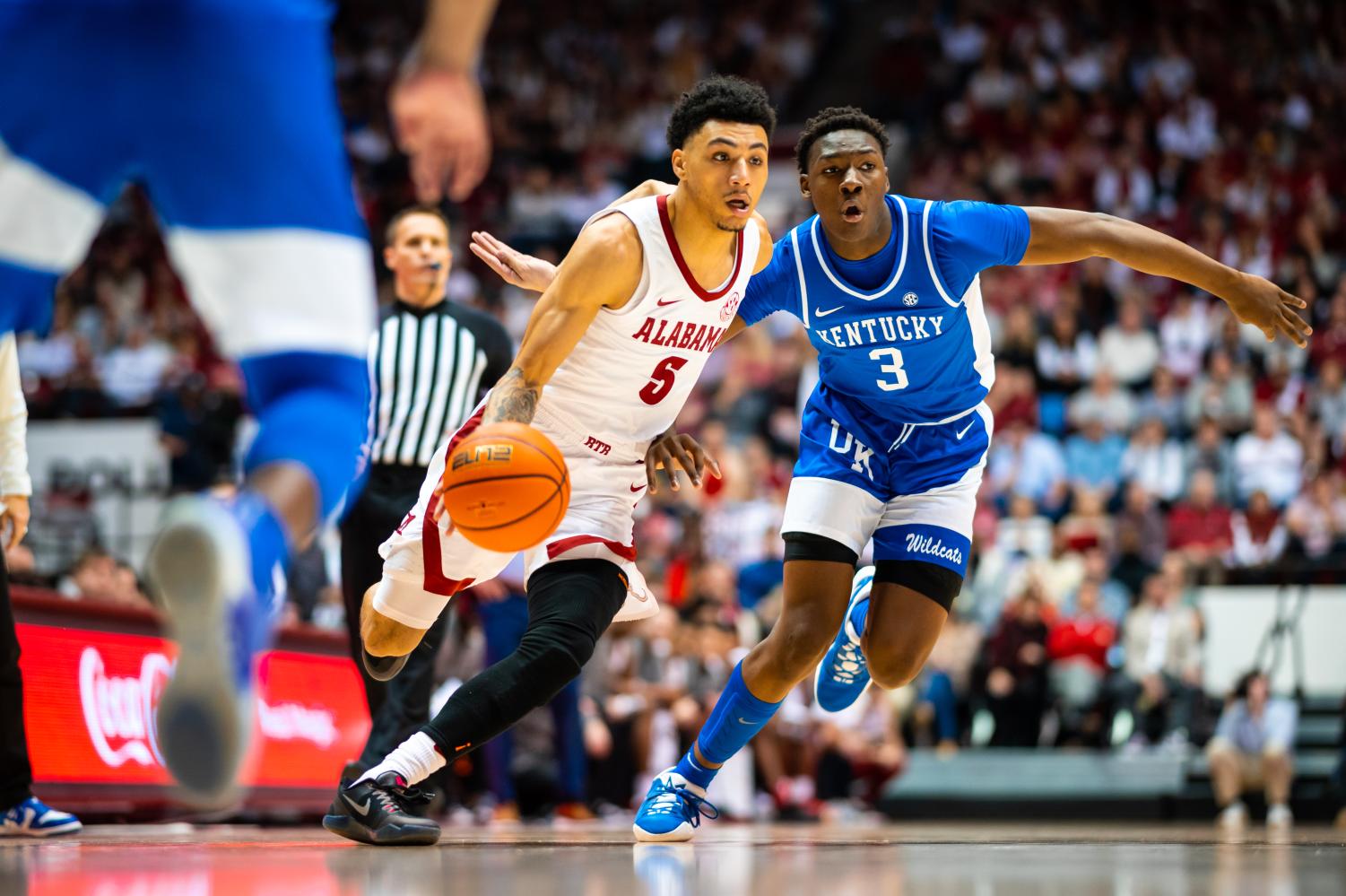One of the first pivotal games of the 2022-23 Razorback basketball season comes on Wednesday night in Bud Walton, as 4th-ranked Alabama comes to town. If the Hogs can win, they have a long stretch of winnable games that follow and could be 7-3 in SEC play by the time we get to February and Nick Smith (hopefully) returns.
But this one will not be easy. The Tide are probably the SEC favorites as of right now.
Meet the Tide
Alabama is coached by Nate Oats, who, like Eric Musselman, is in his fourth season. Oats has enjoyed more regular-season success than Muss, but a single Sweet 16 (in 2021) is the furthest the Tide have ventured in the NCAA Tournament.
Oats has two major analytics-driven strategies that his teams push for:
- Go fast on offense, and make the opponent go slow
- Take all shots at the rim or from 3, and force opponents to shoot midrange
The first comes from a game theory idea that good offenses can usually find a good shot quickly, while bad offenses take a long time to find a shot. This isn’t universally true: defenses that force a lot of turnovers, for example, typically force short possessions from their opponents, since turnovers (by definition) happen earlier than a shot in any given possession.
The second is based on current basketball analytics, which point out that you get less value per shot on midrange jumpers than any other type of shot. Alabama will take almost all of their shots from either behind the arc or at the rim.
From an analytics standpoint, the Tide’s strategy truly optimizes their chances of winning. Of course, games aren’t won on paper. The main downside to Oats’ strategy is that he does not modify it for his talent at all. So last year’s Alabama team, which lacked good 3-point shooters, launched 3-pointers at a high rate anyway, which might help explain why their offense was so difficult to watch. Oats risked falling into the “Shaka Smart trap”, where a coach whose success comes from a very specific system ends up at a bigger school and just recruits the best players he can find, regardless of system fit. That’s why Smart failed at Texas, with all his 4-star recruits unable to execute his signature “Havoc” scheme.
Any concerns that Oats would follow in Smart’s footsteps seem to have been put to rest, however, as the Tide are off to a very strong start to this season.

Alabama has played a very difficult schedule. On neutral floors, they have wins over Michigan State and North Carolina with losses to UConn and Gonzaga. In true road games, they’ve beaten a top-10 Houston team plus a decent Mississippi State team. They also knocked off Memphis and Kentucky at home.

Model pick: Arkansas 76, Alabama 73. The model likes the Tide by a point on a neutral floor, but Bud Walton Arena is not neutral. The model also calls for a blistering 78 possessions in this game. While both teams play fast, I sort of expect Alabama to try to slow things down a bit, while Arkansas wants to speed things up. We’ll see why below.
When Alabama has the ball

The first part of Alabama’s offensive identity: go fast. The Tide are always looking to run and will try and get in transition as often as possible. Their possessions are extremely short, as the Tide are often looking for the first open shot. When forced to slow down, the Tide offense is still pretty good (67th in efficiency), not certainly not elite.
That does raise our first interesting tactical question: does Alabama actually try to go fast? Auburn is also a very fast team, but the Tigers really slowed down against the Hogs (9% transition percent, only 9 points in transition, 17.9 seconds per possession), because… well, look at those numbers for Arkansas’ transition defense. The Hogs are allowing almost nothing in transition. Arkansas is in the top 10 for transition points allowed overall, off live-ball turnovers, and off defensive rebounds.
If Alabama does try to run, they risk creating a game situation that allows Arkansas to run as well (off of transition stops). That’s exactly what Arkansas wants to do, as we’ll discuss below. So don’t be surprised if the Tide slow the pace down a bit and that model pick of 76-73 ends up being a bit high.

Oats calls his offense “drive and space” and it’s premised on the simple idea that good spacing will enable drives to the basket and open 3-pointers. All the green in the bottom right show you that analytics love Alabama’s shot selection. They have the 4th-lowest midrange usage in the country (for midrange, green/good is lower, while for 3s and rim, green/good is higher) and the 25th- and 24th-highest usage of 3-pointers and shots at the rim.
Good shot selection is how Alabama is outside the top 100 in FG% at all three levels… and 29th in overall Effective Field Goal %. When you’re taking the right shots, you don’t actually have to make them at a high rate for it to be worth it.
In terms of shot creation, Alabama is elite at crashing the offensive glass and drawing fouls, just like Auburn. Their bugaboo is turnovers; again, just like Auburn. Continuing the tactical question from above regarding pace: how aggressive will Alabama be on the offensive glass? Auburn’s strategy was to slow down, protect the basketball, and be less aggressive on the offensive boards, so they could ensure that their zone could set up and Arkansas couldn’t run. As a result, Arkansas held off the Tigers on the boards, but couldn’t force turnovers and got nothing in transition. Does Alabama try the same thing? Again, that would require them to deviate from the way they normally play.
Big Three: Brandon Miller, Mark Sears, Jaden Bradley
Alabama’s three most important players consist of a 5-star freshman, a 4-star freshman, and a transfer. Everyone else plays a relative supporting role to these four guys.
First up is 6’8 small forward Brandon Miller, the 5-star freshman. Miller leads the Tide in minutes and in usage (25%), so the Hogs will see plenty of him. He leads Alabama in Box Score Contribution (+8.7… Arkansas’ leader Anthony Black is at +4.9), RAPM (99, Black is 100), and Offensive RAPM (100, Black is 99). What these advanced stats tell us is that Miller makes Alabama an elite team and he does so through his direct, measurable contributions, especially on offense. He’s averaging 19.1 points per game and has an offensive rating of 116.1, easily team-best. He’s a perimeter player, taking about half his shots from beyond the arc and shooting an excellent 44% of those. He’s a decent rebounder, very good passer (9% assist rate is excellent for a small forward), and he doesn’t turn it over too much (15%).
While he can camp off the ball waiting for his defender to leave him, Alabama will frequently let him be ball-dominant. Here, he does a nice job of not taking the bait to be reckless on a drive, and is then rewarded with an open pick-and-pop when Mississippi State doesn’t switch the screen properly:
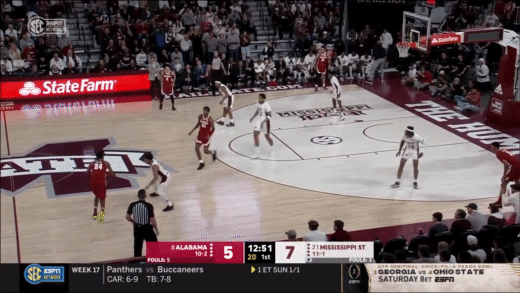
Miller is a danger on both pull-ups and spot-ups. Off the ball, he’ll often sneak into the wing or corner and wait for his man to leave him. If he has the ball, he’ll happily pull-up off a screen if he’s not being defended closely.
He is a much bigger threat from beyond the arc than inside of it. His scoring breakdown is 50-30-20 between 3s-2s-FTs. He’s shooting just 43% inside the arc. While he’ll occasionally cut away from the ball, most of his work inside the arc will be on shots he creates himself.
Here, he isolates Gonzaga’s Anton Watson, but Watson holds is ground nicely and forces a tough shot:
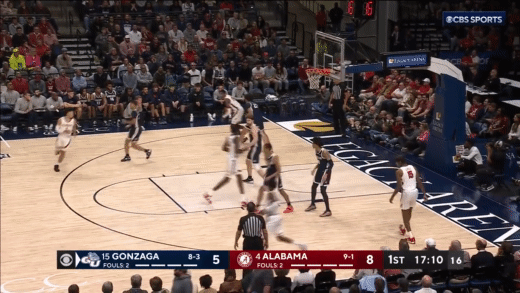
The key to defending him will be to stick to him on the perimeter and force him to work inside, where he is much less physical and doesn’t always get a shot he likes. NBA scouts are probably salivating to watch Jordan Walsh match up with him, as I assume he will. As we’ll see in a second, Alabama’s starting lineup is enormous, so even at 6’9, Miller is only the third tallest starter. The Hogs may need to go with two forwards at times to keep Walsh on Miller.
Miller’s defense is a relative weak point. His Defense RAPM is just 80, which is fourth-best on the Tide and would be just sixth-best on the Hogs. He’s a solid defensive rebounder (17%) and he occasionally blocks a shot or two, but he often fails to anticipate what the offense is doing and struggles to recover from the perimeter. He doesn’t foul too often, though Mississippi State was able to get him in foul trouble and limit his minutes a little bit.
Next up are the two primary guards, 6’1 Mark Sears and 6’3 Jaden Bradley. Sears is an Ohio transfer and 3-point specialist. He’s shooting north of 40% from beyond the arc this season, and more than half his attempts will come from there. His drives to the basket typically come in transition, and he’s above-average at getting fouled, though his 2-point shooting percentages aren’t great when you can defend without fouling. Sears has a 21% usage rate and consistent green light to keep launching 3s. He’ll frequently use a ball screen or a stepback to launch off the dribble:
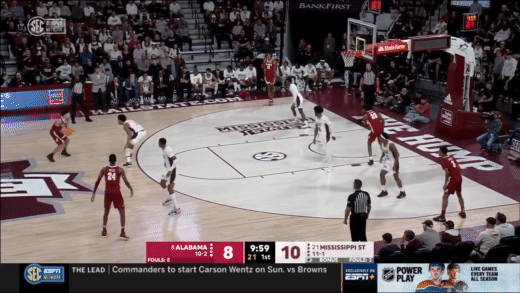
Sears has a slightly elevated turnover rate (19%) and is a very poor rebounder. His DRAPM is just 79, so he’s far from an elite defender.
The other point guard is Bradley, a freshman who has started the last six games following an injury to Nimari Burnett, who is out for a while. His RAPM of 97, ORAPM of 94, and DRAPM of 93 are all third-best on the Tide. Like Sears, he has a 21% usage rate, but he goes about it differently. He’s not a 3-point shooter (only 12 attempts on the year), but is instead of a drive-and-get-fouled guy. He attempts 0.63 free throws per field goal, which is very high. He’s not a great shooter when he’s not getting fouled. He assists on a whopping 25% of made buckets while he’s on the floor thanks to his drive-and-kick abilities and perimeter passing, but he also turns it over way too often (22%).
Sears will need to be tracked closely away from the ball, probably by Devo Davis, who will need to repeat his performance against Mizzou’s D’Moi Hodge. Sears might be slightly better than Hodge at creating his own shot, but it’s still a similar matchup.
With Bradley, you basically just have to stay in front of him. Some ball pressure might force some turnovers, but if you prevent him driving, he’s not a good jump shooter.
Supporting Guards
Alabama’s other two guards off the bench are 6’1 senior Jahvon Quinerly and 6’5 freshman Rylan Griffen. Quinerly is a veteran holdover who Arkansas would love to be very involved. He ranks last on the Tide in offensive rating, defensive rating, Box Score Contribution, RAPM, Offense RAPM, and Defense RAPM. He is easily Alabama’s worst player by any available metric. Offensively, he’s shooting just 44% EFG on a steady diet of 3-pointers. He assists on a team-best 30% of made shots while he’s on the floor, but he’s the most turnover-prone player on the Tide (26%), its worst player at getting to the line (0.17 free throws per field goal), and its worst rebounder (5% total rebound rate). And he does it all with a very high 25% usage. Now that I’ve written all this, I’m sure he’ll go off for 30 points, but “give Quinerly the ball” is a risk that Arkansas is probably willing to live with.
Griffen, on the other hand, is a fun, medium-usage (19%) off-ball guard. He’s a poor shooter (44% EFG) and passer (team-worst 3% assist rate), but he doesn’t it over often and grades as an excellent defender (team-best 95 DRAPM).
Supporting Forwards
One of the unique things about Alabama is that while their 3-point heavy, fast-paced scheme seemingly lends itself to a small, guard-oriented team, the Tide… aren’t. Their starting lineup is enormous: 6’1, 6’3, 6’9, 6’10, 7’0. That trio of forwards makes their starters the biggest lineup they’ll put on the floor (all lineups that include bench players are smaller). If you can’t hang with their size, you’ll get dominated on the glass and kept away from the rim, which would be a huge problem for Arkansas. That said, Arkansas should be able to force them out of this big lineup.
The main power forward is 6’10 freshman Noah Clowney. Clowney is a stat-stuffer. He grades as the team’s best overall rebounder (17%) and defensive rebounder (23%). On offense, he’s a perimeter player like Miller, though he’s not nearly as good at creating his own shot and is only shooting 31% from beyond the arc. He gets fouled a good bit, but he also turns it over too much (21%). The primary downside with Clowney is that he grades a fairly poor defender (DRAPM of 63, 7th-best on the team). He can block some shots as a help defender but is often out of place.
The final starter is an old friend: 7’0 center Charles Bediako, who ate the Hogs’ lunch in Tuscaloosa last year. Bediako is the only non-perimeter player on the Tide. He’s very low usage (12%) and mostly gets by on offense by cleaning up missed shots, thanks to his team-best 16% offensive rebound rate. Beyond that, he grades as a low-impact offensive player and Alabama’s offense is actually better when he’s on the bench. But defensively, his DRAPM of 90 is fourth-best on the team. He blocks 2.1 shots per game as the team’s rim protector.
However, while he puts his quick hands to use on offensive boards…
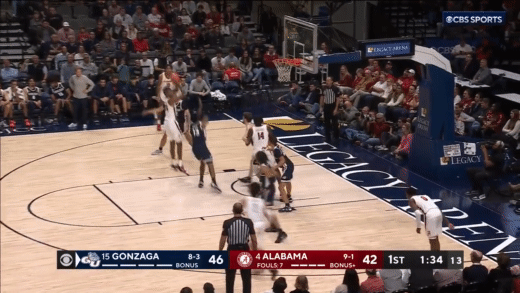
…he does not have particularly quick feet, which causes a problem for him against athletic opponents. He is severely limited by fouls: he’s committed 4+ fouls in all three true road games and in six of seven games Alabama has played away from home. The Hogs can probably get him to the bench quickly by going right at him, which will force the Tide into a smaller lineup with Clowney at the 5.
Off the bench, we may see a bit of 6’8 sophomore Noah Gurley, largely in place of Miller or Clowney. Gurley is another perimeter player who takes about half his shots from beyond the arc, but he’s not an elite shooter and he doesn’t draw many fouls. He turns it over too much (22%). He does grade as a good defender (DRAPM of 93, third on team).
How will Arkansas defend?
Alabama’s offense is a sneaky challenge because their overall efficiency of 28th is slightly understated by the fact that the Tide tend to flip the “off” switch against weak opponents. They graded poorly in wins over Longwood, South Alabama, and Jackson State, but their offense has graded at 85+ in every SEC game and also looked really strong in that win over Houston and the loss to Gonzaga. There’s another level of intensity there that they may need in Fayetteville.
If there’s a slow whistle, that will hurt Alabama’s offense but help its defense. That’s what happened against North Carolina, a 103-101 Tide victory in four overtimes. Alabama shot just 46% at the rim – same number Arkansas shot at the rim against Auburn – thanks to a stingy Carolina defense. Their 98.1 offensive efficiency was quite poor considering that the Tar Heel defense ranks just 84th in defensive efficiency. Of course, that impacted the other side of the ball: the slow whistle allowed Bediako to play 44 minutes, and he had a monster game (14 points, 16 rebounds, second-highest-graded Alabama player).
The Tide want to get their main ballhandlers (Sears, Bradley, Miller) going downhill and to the rim. Their 3-point shooting largely exists to keep the defense out away from the basket to create those driving lanes. They’ll do a lot of stuff similar to Arkansas, like using a big to set a high ball screen and create a path to the hoop, like in this example, where Clowney doesn’t even have to set the screen for it to be effective:
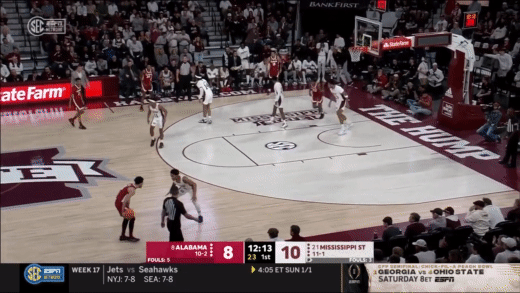
Mississippi State rotates really nicely here and takes away any potential shot, but you can still see how Alabama’s spacing is dangerous against man defense. The Tide are too tall to play with no true center, but you risk mismatches if you try to play with one.
The good news is that Arkansas is very good at defending this kind of stuff. Hog defenders do a nice job of playing on balance and keeping their feet moving on the ball. If the Razorbacks can fight through screens and take away most of the perimeter shooting – especially from Miller and Sears – then they just need to force a few turnovers and do just enough on the defensive glass to give themselves a chance to win.
The final key is turnovers. Arkansas prides itself on turning opponents over, but that hasn’t happened in SEC play. The Hogs’ three opponents had turnover rates of 15%, 15%, and 11%, and Arkansas lost the turnover battle in all three games. Opponents seem to have figured out that taking care of the basketball will prevent the Hogs from getting in transition. Alabama is, like LSU and Auburn, a bit turnover-happy, so the Hogs absolutely have to find a way to force some.
When Arkansas has the ball

Alabama’s defense wants to be the opposite of its offense: they want to keep the opponent out of transition and trapped in long halfcourt possessions, where they are very good.
The Tide turn it over too often and that occasionally hurts them going the other way, which is, as we discussed, the main way Arkansas can run and beat that halfcourt defense. Arkansas is still 19th in transition scoring off turnovers despite three bad games in that department in a row. They need several points off turnovers to have a chance in this one.

Few teams in the country are better at smothering the perimeter and limiting open 3-pointers. Alabama will give you plenty of shot chances (268th in effective possession ratio because they don’t force turnovers) but they’ll defend your shots well (4th in effective field goal percentage) largely by forcing you into difficult shot selection. Opponents end up taking a lot of midrange jumpers against the Tide.
How do they do this? Well, like a typical man-to-man team, they smother the perimeter by staying out on shooters and fighting through screens. However, much like Arkansas, the Tide are very scout-heavy. They identify shooters and stick to them, but they will happily leave players deemed non-shooters wide open:
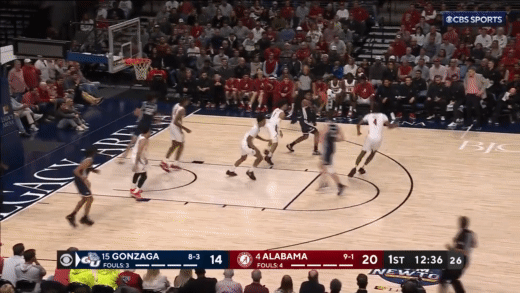
Here’s another example, where the on-ball guard aggressively takes Rasir Bolton, but once Bolton gets inside the arc, no Tide low defender comes up to help, ceding the midrange floater to the Zags:
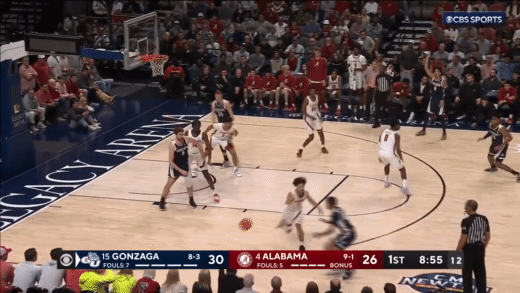
Gonzaga was happy to take what Alabama gave them. The Zags took almost half their shots from midrange and shot a ridiculous 63% on them, allowing them to put 100 points on the Alabama defense.
That’s not the only way to beat this defense, though. UConn barely took any midrange shots at all. Star center Adama Sanogo got Bediako in foul trouble, opening clean paths to the rim. Even when Bediako was in there, the Huskies pulled him away and let their guards beat the Tide in 1-on-1s:
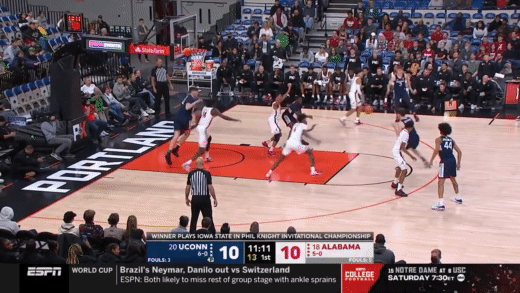
Sears in particular will struggle to stay 1-on-1 with Black and Council because he is only 6’1.
That leads to the biggest question of all: does Alabama go zone? Oats is a bit of a stubborn system guy, so it would not surprise me if he wanted to lean on his scheme here, but if you’re watching Arkansas, you have to be thinking that zone is the best option. The Razorbacks have lots of guys that can shred man-to-man defense because their jumbo guards can create mismatches.
The Tide might try to play man with Bediako and then go zone when he comes out, either to rest or because of fouls. But the Hogs have to prepare for at least some zone, since it seems like every team will play it.
Keys to the Game
- Big swing in the turnover battle. Arkansas can’t just win the turnover battle: they have to dominate it. If this game turns into a shooting contest between two teams with equal opportunities to shoot, the Hogs are probably going to lose, and probably going to lose badly. But Alabama turns it over a lot and doesn’t force many of their own, while Arkansas is the opposite. The Hogs need to go +6 or better here.
- Crank up the pace. Alabama wants to go fast themselves but slow Arkansas down. The Hogs can flip the script by converting the turnovers they force into fast breaks, forcing Alabama into a much more chaotic game. If you’re the worse-shooting team, you need chaos, and speed is a great way to create it.
- If you see zone, crash the offensive boards. Arkansas is not good enough to out-shoot a zone defense. They’ll need Black to pick it apart off screens, but offensive rebounding will be the key. Kamani Johnson and Jalen Graham are the Hogs’ best offensive rebounders, so they may need to play big minutes if the Tide to try to zone the Hogs.
Thanks for reading! Be sure to follow us on Twitter and on Facebook.
The latest from Fayette Villains, straight to your inbox
Enter your email to subscribe and receive new post alerts and other updates. You can unsubscribe at any time.
